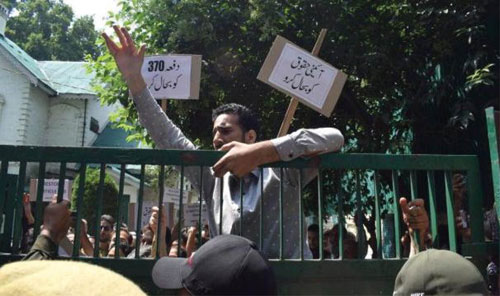In the days that followed the [Indian] government’s decision to amend Article 370 and split the State into two Union Territories, there was a deafening silence in Kashmir. A total curfew had been imposed, thousands were arrested, many of them held captive in their own homes, internet and mobile telephones were switched off, and those with working phones much too frightened to say anything over them. It is this silence that Anuradha Bhasin’s A Dismantled State: The Untold Story of Kashmir after Article 370 speaks about most eloquently. Like Shirley Toulson’s famous words about grief, Kashmir’s “silence silences”.‘Be quiet…
’In one poignant paragraph, Bhasin, editor of Kashmir Times newspaper, sums it up like this: she writes about a fellow journalist, a Kashmiri based in Delhi, who speaks of the humiliation when “your parents call after two weeks, able to do so after trekking three kilometres from home, standing in a queue for a painfully brief call just to say that they are fine, and to add ‘be quiet, don’t say a word’.” It is a humiliation ordinary Kashmiris have lived with for more than three years now, as the government has taken pride in its complete control of the place, and supporters of the government’s move across the country have exulted in the decision. For most part, Bhasin doesn’t question the Modi government’s decision on Article 370, as much as the means it adopted to deliver the decision.
After all, Article 370 itself has been read down dozens of times since it was introduced, by none more than Prime Minister Jawaharlal Nehru himself, and then by his successors, as special powers to the State were whittled away. However, its formal abrogation has always been tied to a final settlement of the dispute, as a sort of ribbon-cutting to such an eventuality in the future. Instead, the government’s act suggests that it does not recognise Kashmir as a dispute any more, and in its re-imagination of Kashmir as “Naya Kashmir” can seek to create Jammu and Kashmir as a peaceful and prosperous version of the present, ‘freed’ of its political leadership and welcoming of non-Kashmiris keen to live and work there as investment pours in.
Myths and reality Bhasin has, however, ripped the band-aid off those ideas. She explains the myths that surrounded Article 370: the J&K High Court ruled against the provision taking away property rights of women who married outside the State in 2005, for example, and the clause has been inactive since. The return of Kashmiri Pandits to the Valley, a crucial and important outcome, has not been guaranteed by the strike on Article 370 either — if anything, the community of Pandits, long exiled in their own country and buffeted as a political football by several governments, have only been made to feel less secure as a result of it. Perhaps the sharpest commentary in the book is from the quotations chosen at the beginning of each chapter that speak volumes in a phrase: “Fear cuts deeper than swords” says one, “When truth is replaced by silence, then the silence is a lie,” says another.
The book makes no pretence that things were better pre-2019. In fact, Bhasin’s searing pen has castigated all the players in Kashmir’s tortured history without exception — India, Pakistan, politicians in Jammu and Kashmir, as well as the militants…..
Eventually, Bhasin’s work is less a historical or political analysis of Kashmir’s past as it is a painstaking day-by-day account of what has happened in the entire state of Jammu, Kashmir and Ladakh since August 5, 2019. If journalism is the first draft of history, A Dismantled State fulfils the author’s role of recording for posterity the powerlessness and helplessness that came home to people living in her State that day.










